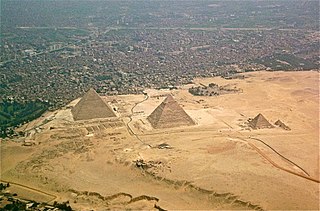
A pyramid is a structure whose outer surfaces are triangular and converge to a single step at the top, making the shape roughly a pyramid in the geometric sense. The base of a pyramid can be trilateral, quadrilateral, or of any polygon shape. As such, a pyramid has at least three outer triangular surfaces. The square pyramid, with a square base and four triangular outer surfaces, is a common version.
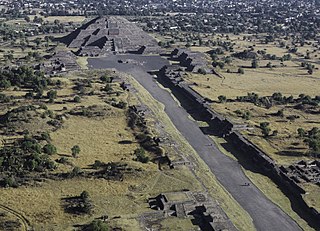
Teotihuacan is an ancient Mesoamerican city located in a sub-valley of the Valley of Mexico, which is located in the State of Mexico, 40 kilometers (25 mi) northeast of modern-day Mexico City. Teotihuacan is known today as the site of many of the most architecturally significant Mesoamerican pyramids built in the pre-Columbian Americas. At its zenith, perhaps in the first half of the first millennium, Teotihuacan was the largest city in the pre-Columbian Americas, with a population estimated at 125,000 or more, making it at least the sixth-largest city in the world during its epoch.

Cholula, officially Cholula de Rivadavia, is a city and district located in the metropolitan area of Puebla, Mexico. Cholula is best known for its Great Pyramid, with the Iglesia de Nuestra Señora de los Remedios sanctuary on top, as well as its numerous churches.

José María Herediay Heredia, also known as José María Heredia y Campuzano was a Cuban-born poet considered by many to be the first romantic poet of the Americas and the initiator of Latin American romanticism. More recently, this view has been qualified, highlighting Heredia's roots in Neoclassicism and the aesthetics of eighteenth-century Sensibility. He is known as "El Cantor del Niagara" and regarded as one of the most important poets in the Spanish language. He has also been named National Poet of Cuba.

The Great Pyramid of Cholula, also known as Tlachihualtepetl, is a huge complex located in Cholula, Puebla, Mexico. It is the largest archaeological site of a pyramid (temple) in the New World, as well as the largest pyramid by volume known to exist in the world today. The adobe brick pyramid stands 55 metres (180 ft) above the surrounding plain, far shorter than the 137 metres (449 ft) of the Great Pyramid at Giza, but is much wider, in its final form measuring 450 by 450 metres, vs the Giza pyramid at 230 by 230 metres. The pyramid is a temple that traditionally has been viewed as having been dedicated to the god Quetzalcoatl. The architectural style of the building was linked closely to that of Teotihuacan in the Valley of Mexico, although influence from the Gulf Coast also is evident, especially from El Tajín.

Mesoamerican pyramids form a prominent part of ancient Mesoamerican architecture. Although similar in some ways to Egyptian pyramids, these New World structures have flat tops and stairs ascending their faces. The largest pyramid in the world by volume is the Great Pyramid of Cholula, in the east-central Mexican state of Puebla. The builders of certain classic Mesoamerican pyramids have decorated them copiously with stories about the Hero Twins, the feathered serpent Quetzalcoatl, Mesoamerican creation myths, ritualistic sacrifice, etc. written in the form of hieroglyphs on the rises of the steps of the pyramids, on the walls, and on the sculptures contained within.
Xelhua is one of the seven giants in Aztec mythology who escaped the flood by ascending the mountain of Tlaloc in the terrestrial paradise and afterwards built the Great Pyramid of Cholula. One of the six giants sons of Mixcoatl, the personification of the Milky Way. A Dominican friar wrote this account:
Before the great inundation which took place 4,800 years after the erection of the world, the country of Anahuac was inhabited by giants, all of whom either perished in the inundation or were transformed into fishes, save seven who fled into caverns. When the waters subsided, one of the giants, called Xelhua, surnamed the 'Architect,' went to Cholula, where, as a memorial of the Tlaloc which had served for an asylum to himself and his six brethren, he built an artificial hill in the form of a pyramid. He ordered bricks to be made in the province of Tlalmanalco, at the foot of the Sierra of Cecotl, and in order to convey them to Cholula he placed a file of men who passed them from hand to hand. The gods beheld, with wrath, an edifice the top of which was to reach the clouds. Irritated at the daring attempt of Xelhua, they hurled fire on the pyramid. Numbers of the workmen perished. The work was discontinued, and the monument was afterwards dedicated to Quetzalcoatl.

Mesoamerican architecture is the set of architectural traditions produced by pre-Columbian cultures and civilizations of Mesoamerica, traditions which are best known in the form of public, ceremonial and urban monumental buildings and structures. The distinctive features of Mesoamerican architecture encompass a number of different regional and historical styles, which however are significantly interrelated. These styles developed throughout the different phases of Mesoamerican history as a result of the intensive cultural exchange between the different cultures of the Mesoamerican culture area through thousands of years. Mesoamerican architecture is mostly noted for its pyramids, which are the largest such structures outside of Ancient Egypt.

Talud-tablero is an architectural style most commonly used in platforms, temples, and pyramids in Pre-Columbian Mesoamerica, becoming popular in the Early Classic Period of Teotihuacan. Talud-tablero consists of an inward-sloping surface or panel called the talud, with a panel or structure perpendicular to the ground sitting upon the slope called the tablero. This may also be referred to as the slope-and-panel style.

Cholula was an important city of pre-Columbian Mesoamerica, dating back to at least the 2nd century BCE, with settlement as a village going back at least some thousand years earlier. The site of Cholula is just west of the modern city of Puebla and served as a trading outpost. Its immense pyramid is the largest such structure in the Americas, and the largest pyramid structure by volume in the world.
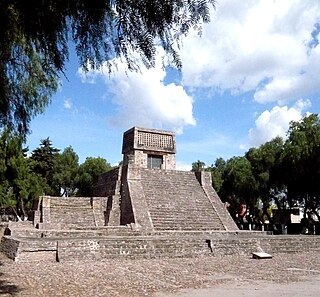
Aztec architecture is a late form of Mesoamerican architecture developed by the Aztec civilization. Much of what is known about it comes from the structures that are still standing. These structures have survived for several centuries because of the strong materials used and the skill of the builders.

The Coyolxāuhqui Stone is a carved, circular Aztec stone, depicting the mythical being Coyolxāuhqui ("Bells-Her-Cheeks"), in a state of dismemberment and decapitation by her brother, the patron deity of the Aztecs, Huitzilopochtli. It was rediscovered in 1978 at the site of the Templo Mayor of Tenochtitlan, now in Mexico City. This relief is one of the best known Aztec monuments and one of the few great Aztec monuments that have been found fully in situ.

Acatitlan is an archeological zone of the early Aztec culture located in the town of Santa Cecilia, in the municipality of Tlalnepantla de Baz in Mexico State, about 10 km northwest of Mexico City. In pre-Hispanic times it was located on the northwest shore of the great Lake Texcoco.
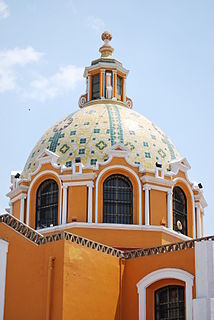
The Iglesia de Nuestra Señora de los Remedios is a 16th-century Mexican Catholic parish church built atop the Tlachihualtepetl pyramid in the municipality of Cholula located in the central Mexican state of Puebla. The church was built with carved stone and embellished with 24-carat gilded panels and shims, called laminilla. It has an altar in the neoclassical style. It was built between May 1574 and August 1575 and consecrated on March 25, 1629. The base on which the church is built is one of the largest pyramids of the ancient world, being 54 metres (177 ft) high, covering 54 acres and shaped by several superimposed structures over the course of six centuries.

San Andrés Cholula Municipality is a municipality in Puebla in south-eastern Mexico. It forms part of the Metropolitan area of Puebla, and as of 2011, it is the fastest-growing municipality that conforms the Metropolitan Area, partly because the presence of universities and the wealthiest neighborhoods are located on San Andres Cholula. Along with San Pedro Cholula and Santa Isabel Cholula, it conforms the most ancient still inhabited city in the Americas, Cholula de Rivadabia.
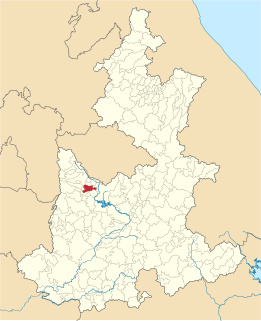
San Pedro Cholula is a municipality in the Mexican state of Puebla and one of two municipalities which made up the city of Cholula. The city has been divided into two sections since the pre Hispanic era, when revolting Toltec-Chichimecas pushed the formerly dominant Olmec-Xicallanca to the eastern side of the city in the 13th century. The new lords called themselves Cholutecas and built a new temple to Quetzalcoatl on the San Pedro side, which eventually eclipsed the formerly prominent Great Pyramid of Cholula, now on the San Andrés side. When the Spanish arrived in the 16th century, the city of Cholula was an important religious and economic center, but the center of power was on the San Pedro side, centered on what is now the main city plaza and the San Gabriel monastery. The division of the city persisted and San Pedro remained the more dominant, with Spanish families moving onto that side and the rest of the population quickly becoming mestizo. Today, San Pedro is still more commercial and less residential than neighboring San Andrés with most of its population employed in industry, commerce and services rather than agriculture. Although Cholula's main tourist attraction, the Pyramid, is in San Andrés, San Pedro has more tourism infrastructure such as hotels, restaurants and bars.

A capilla abierta or “open chapel” is considered to be one of the most distinct Mexican construction forms. Mostly built in the 16th century during the early colonial period, the construction was basically an apse or open presbytery containing an altar, which opened onto a large atrium or plaza. While some state that these were constructed by friars because the native peoples of that epoch were afraid to enter the dark confines of European-style churches, the more likely reasons for their construction were that they allowed the holding of Mass for enormous numbers of people and the arrangement held similarities to the teocallis or sacred precincts of pre-Hispanic temples. While open chapels can be found in other places in Spain and Peru, their systematic use in monasteries and other religious complexes, leading to a regularization of architectural elements, is only found in Mexico.

The Storming of the Teocalli by Cortez and his troops is an 1848 oil on canvas painting by the German American history painter, Emanuel Leutze.

Mendicant monasteries in Mexico were one of the architectural solutions devised by the friars of the Mendicant orders in the 16th century to the evangelization in the New Spain. The religious function of these buildings was thought for an enormous number of Amerindian indigenous people to evangelize although soon, due to the policy of reduction, the whole became the social center of the pueblos de indios, transmitting to them the civil modes of the West, Castilian, various arts and crafts, health, and even funeral services.

















